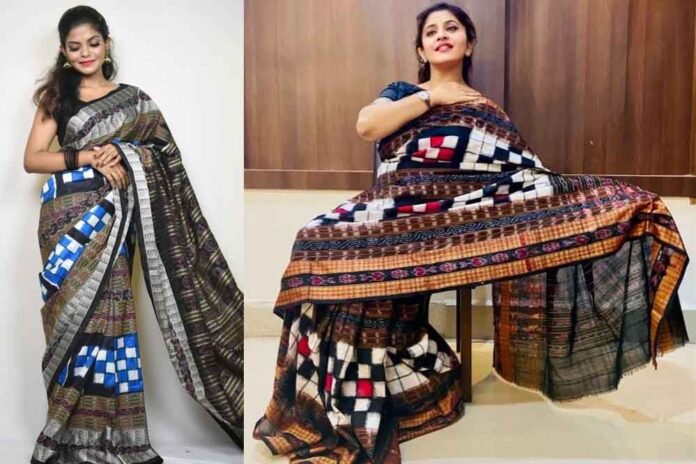Bichitrapuri cotton saree is a handwoven textile tradition that originates from the Bargarh district of Odisha, India. This saree is also known as the Pasapali saree and is famous for its unique design, which includes rows of chequered patterns woven in contrasting colors on the main body.
Bichitrapuri cotton saree includes rudraksha beads, aquatic animals like fish and ducks, floral patterns, as well as animal figures such as elephants and deer. Conch shells, tortoises, and swans are also commonly featured.
The Bichitrapuri cotton saree can be traced back to the 19th century and is an essential component of Odia fashion. It is typically worn for special occasions like weddings, festivals, and religious ceremonies.
The Bichitrapuri cotton saree holds special significance in Odia culture, as it symbolizes the cultural heritage and pride. It is often worn to demonstrate one’s connection to Odia traditions and customs. Moreover, it is a sustainable fashion choice that supports the livelihoods of skilled.
Crafting a Bichitrapuri cotton saree is a meticulous and time-consuming process that requires the expertise of various skilled artisans, including designers, tiers, dyers, and weavers. The traditional Odisha ikat process is used, which involves tying and dyeing the warp and weft threads on a fly shuttle pit loom before weaving. After the yarns are tied based on the pattern, they are dyed, dried, and subsequently woven on the loom.
The creation of the Bichitrapuri cotton saree requires years of training and practice to perfect. Although creating these sarees involves a complex and time-consuming process, they are greatly prized for their intricate designs and vibrant colors, making them a sought-after option for special events not only in Odisha but also in other places.
The primary difference between the production process of Bichitrapuri cotton saree and that of silk Bichitrapuri saree lies in the choice of yarn used. Cotton yarn is used in the former, resulting in a lightweight and breathable fabric suitable for everyday wear.
The main body of the saree showcases check designs consisting of vivid white, red, and black squares that are made more striking through the application of the double ikat technique. The colors of the saree are predetermined, and the dyed threads are woven together to produce the final textile.
Bichitrapuri cotton saree’s exquisite craftsmanship and unique design have not gone unnoticed, as it has gained widespread recognition in India and beyond. Fashion designers have been particularly drawn to the saree’s intricate designs and vibrant colors, which offer a unique and eye-catching addition to their collections.
The saree’s popularity has also been fueled by its cultural significance and sustainability. Its sustainable production methods and support for skilled artisans make it an attractive option for those seeking environmentally conscious fashion choices.
The Bichitrapuri cotton saree represents India’s rich textile heritage and the skilled artisans who create them. With its exquisite craftsmanship and unique design, the saree has been featured in numerous fashion shows and exhibitions, garnering the attention of fashion designers worldwide.



